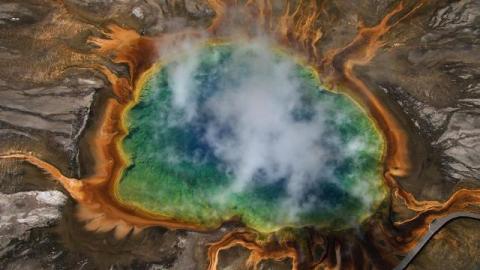Yellowstone: The public and media obsession with the caldera

Sometimes I think that people have an unhealthy obsession with Yellowstone Caldera. Sure, it is big, powerful and the stuff that disaster movies are made, but in terms of a volcanic system that poses a high threat to life/property in the U.S. on a daily basis, it is relatively low. I know what you are thinking (well, some of you): “How can you say that? Look at how big the past eruptions were?” Yes, indeed, the previous eruption from the modern Yellowstone Caldera were indeed big, some of the biggest we have identified on the continents (it is still no Fish Canyon Tuff), so I’ll give you that. However, looking at the recent volcanic history of Yellowstone, you’d see that these big “doomsday” eruptions are only a very small piece of its activity, so even if tomorrow the caldera began to show signs of imminent eruption, there is a very good chance that it would be a relatively minor eruption – possibly on the scale of the 2008 and onward Chaiten eruption in Chile.
So, why is it that when a fairly innocuous paper comes out, everyone gets all riled up? National Geographic had a piece about a December 2010 article in Geophysical Research Letters by Chang and others called “An extraordinary episode of Yellowstone caldera uplift, 2004-2010, from GPS and InSAR observations“. Alright, I can see why it might catch a reporter’s attention: “extraordinary episode” combined with “caldera uplift” all in the recent past (2004-2010) seems juicy. Well, dissecting the article it seems that the key findings are (a) a large area of the Yellowstone caldera has been rising since 2004 (b) from 2004-06, the surface was rising 7-5 cm/yr; from 2006-08, rising 4-2 cm/yr and from 2008-2010, rising 2-0.5 cm/yr and (c) the source of this uplift was likely a sill intruding at 7-10 km depth (see figure below). The Yellowstone Volcano Observatory press release about the paper is pretty subdued, which isn’t surprising considering that if research like this makes it to publication, then the data in it is “old news” to the scientific community. Whenever you read about a “shocking” new research paper, remember, that data is likely a year or more old and has been vetted by many people in the research community – not exactly breaking events.

Now, should we expect this at an active caldera? Yes! Does this mean that the caldera is going to erupt soon? Maybe! Will it destroy us all? Probably not!
However, much like much news on the internet, information gets run through a massive game of telephone. This news about Yellowstone morphed into more 2012-style doomsday news. Some fine examples:
Tuscon Citizen: Fairly reasonable look at Yellowstone Caldera until you get to the bottom, where the National Park Service assessment of the activity at Yellowstone as being fairly low with no signs of a “catastrophic eruption is imminent” is juxtaposed with the findings in the Chang et al. paper. This is exactly what you shouldn’t do as there is no indication in the paper that its findings are in conflict with the idea that a catastrophic is not around the corner.
Daily Mail: The headline alone takes it to another level: “Is the world’s largest super-volcano about to erupt for the first time in 600,000 years, wiping out two-thirds of the U.S.?” I can’t remember who said this, but if the title of your article can be answered with “no”, then maybe you need to rethink the title, or the article in general. Sadly, it gets worse as the potential eruption at Yellowstone is described as “spewing lava far into the sky” and the U.S. will become uninhabitable by “toxic air”, then goes on to say that a new “supereruption” could be coming in the “near future”. There is much less information about Yellowstone in the article and very little from the original GRL article – heck, it isn’t even mentioned. I’m not even sure what the “scorched earth” image is halfway through the article. And other media websites that have picked up this piece have morphed the title to “Largest volcano ‘to erupt after 600,000 years, wipe out 2/3 of U.S.” Ugh. (This spoof does a good job describing the Daily Mail‘s coverage)
San Francisco Chronicle (picked up from Benzinga): Now, we get completely wrong headlines from Jonathan Chen of Benzinga.com: “Could the world’s oldest volcano wipe out more than 50% of the US?” Where do I start? Yellowstone is clearly not the “world’s oldest volcano”. Not even close. Could it wipe out 50% of the US? Maybe it could, likely it wouldn’t (see my note for the Daily Mail). Here, the study is cut down to two quotes with very little info beyond the absolutely terrible and wrong headline.
Gawker: At least Gawker was having a little fun with Yellowstone, right down to the hashtag #volcanofail. Even their brief synopsis of what will happen during a catastrophic eruption isn’t too bad, at least saying that the caldera will erupt ash to 25 km rather than lava. The best line, though, sums up the Yellowstone hysteria nicely: “But who do you trust, some kind of “professor,” or your overactive imagination?”
UPDATE: Now, this one really baffled me. CNN’s Rebecca Hillman asked physicist Michio Kaku for his prediction about Yellowstone. Really? Should someone interview me about the existence of dark matter? This is a prime example of lazy reporting: get the first expert on the line and end it there.
There you go. Yellowstone is pretty calm as giant caldera systems go. We have such a small record of the behavior of a “restless caldera” that this inflation at Yellowstone could very easily fall into the realm of normal, non-eruption-causing behavior. And if you ever worry, Yellowstone is also well-wired to see all the real time data, including earthquakes in the region and in the park, temperatures of hot springs, webcams, deformation within the caldera and hydrologic changes in the area. You would expect that if Yellowstone were headed towards an eruption, we would see lots of rapid inflation, lots of constant seismicity that gets shallower through time, a change in the temperature/composition of the hydrothermal systems and possibly even cracks forming in the land around the caldera. In other words, there will be lots of signs. So, the next time you see a doomdays article about Yellowstone, remember, calderas are busy places and the media loves its disasters.
Top left: Grand Prismatic Spring at Yellowstone Caldera





